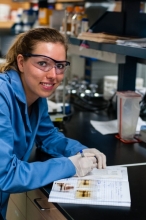
University:
Major:
Mentor(s):
Faculty Sponsor(s):
Faculty Sponsor's Department:
Project Title:
Project Description:
Abnormal aggregation and fibrilization of the microtubule-binding protein, tau, is a pathological hallmark of many neurodegenerative diseases, including Alzheimer’s disease (AD). Several lines of evidence suggest that small soluble tau oligomers at early stage of disease progression are the primary toxic species in AD. However, structural characterization of the oligomers at the molecular level has proven to be challenging due to their transient and metastable nature, as well as their existence in a mixture of monomers and other large assemblies.
Here, we investigate the population and structure of soluble tau oligomers before the onset of large fibrils formation using photochemical cross-linking and gel electrophoresis. This method directly produces covalent bonds between closely interacting aromatic peptide side chains within an oligomer in a very short reaction time (<few sec), providing a snapshot to visualize the quaternary structures of the native oligomers formed at early stage of aggregation. We found that dimer and trimer begin to appear at 5 min of aggregation. The populations of higher order oligomers increase with increasing aggregation time. Kinetic analysis suggests that these oligomers are not formed by artifactual diffusion-limited cross-linking. Finally, to understand the relation of tau oligomers to AD, we attempt to purify these oligomers, in order to study their local structures involved in protein-protein contacts and the propagation of each oligomer in neuron cells. This unique approach presented herein provides a great potential to gain molecular insight into the mechanism of tau oligomer at early stage of aggregation in AD.
